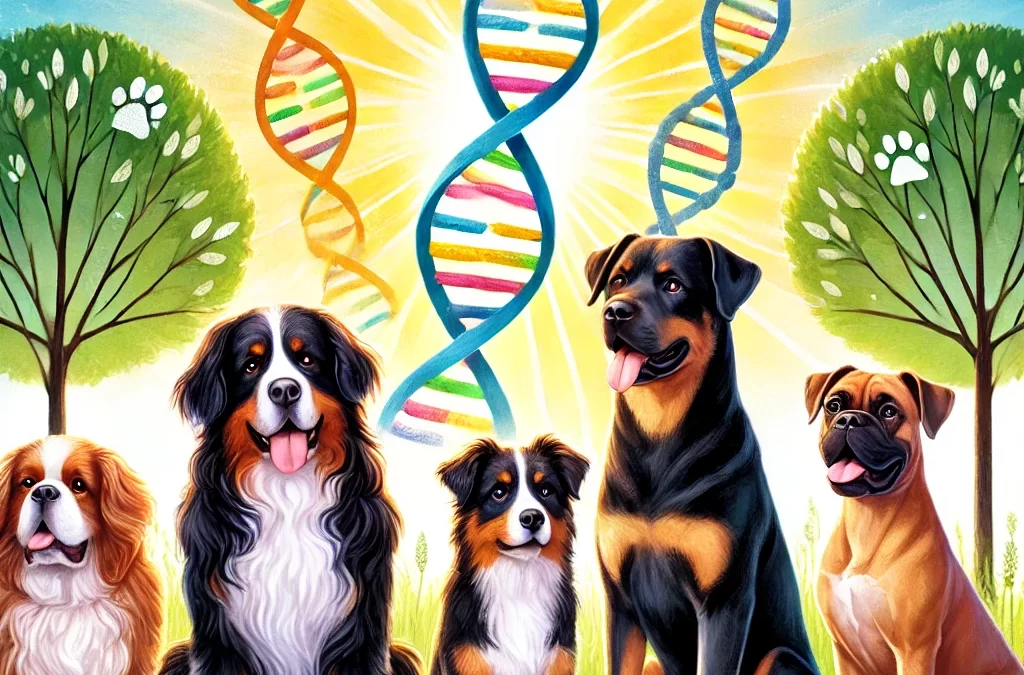
utworzone przez TCMVET | gru 6, 2024 | Rak i guzy u psów
Gdy ukochany zwierzak zostanie zdiagnozowany z rakiem, może to być trudna podróż dla każdego właściciela zwierzaka. Zbadanie odpowiednich opcji leczenia i suplementów staje się kluczowe dla zapewnienia im komfortu i jakości życia. Spośród niezliczonej liczby suplementów na raka dla zwierząt dostępnych online, TCMVET Baituxiao wyróżnia się jako naturalna i skuteczna opcja, przeznaczona do pomocy w leczeniu i zwalczaniu wzrostu guzów u psów i kotów.
Zrozumienie roli suplementów przeciwnowotworowych w opiece nad zwierzętami domowymi
Rak u zwierząt domowych często prowadzi do dyskomfortu fizycznego, obniżonego poziomu energii i obniżonej odporności. Podczas gdy konwencjonalne metody leczenia, takie jak operacja, chemioterapia lub radioterapia, mogą być skuteczne, często wiążą się z wysokimi kosztami i potencjalnymi skutkami ubocznymi. W tym miejscu naturalne suplementy mogą odegrać rolę pomocniczą, mając na celu:
- Wzmacnia układ odpornościowy.
- Powolny wzrost guza.
- Poprawa ogólnego samopoczucia i poziomu energii.
- Zmniejsza stan zapalny i dyskomfort.
Łącząc tradycyjne terapie z suplementami o potwierdzonym naukowo działaniu, możesz dać swojemu pupilowi szansę na zdrowsze i wygodniejsze życie.
Czym jest TCMVET Baituxiao?
TCMVET Baituxiao to specjalistyczna formuła ziołowa oparta na zasadach Tradycyjnej Medycyny Chińskiej (TCM). Opracowana specjalnie dla zwierząt domowych, wykorzystuje moc naturalnych składników, aby:
- Zmniejszenie wzrostu guza:Jego unikalna mieszanka ma na celu zahamowanie nieprawidłowej proliferacji komórek, co pomaga spowolnić wzrost guzów.
- Wsparcie ogólnego stanu zdrowia:Dzięki właściwościom wzmacniającym odporność wspomaga naturalne mechanizmy obronne Twojego pupila.
- Złagodzić objawy:Baituxiao może zmniejszyć stan zapalny i zwiększyć poziom energii, dzięki czemu Twój pupil pozostanie aktywny i szczęśliwy.
Dlaczego warto wybrać TCMVET Baituxiao?
- Naturalne składniki:Baituxiao nie zawiera żadnych syntetycznych dodatków. Wykorzystuje składniki ziołowe, które są delikatne dla ciała Twojego pupila.
- Zatwierdzone przez weterynarza:Wielu lekarzy weterynarii popiera stosowanie tej metody jako części zintegrowanego planu leczenia zwierząt cierpiących na guzy.
- Formuła naukowa:Łącząc nowoczesne badania z wiedzą ekspercką w zakresie medycyny chińskiej, TCMVET Baituxiao jest starannie opracowany, aby zapewnić bezpieczeństwo i skuteczność.
Jak korzystać z TCMVET Baituxiao
Stosowanie TCMVET Baituxiao jest proste i wygodne. Można go podawać doustnie lub mieszać z jedzeniem, aby ułatwić jego spożycie. Dawki są dostosowywane w zależności od wielkości zwierzęcia i konkretnych potrzeb zdrowotnych, zapewniając optymalne rezultaty. Zawsze skonsultuj się z lekarzem weterynarii przed wprowadzeniem jakiegokolwiek nowego suplementu do rutyny swojego zwierzęcia.
Gdzie kupić TCMVET Baituxiao online
Możesz wygodnie kupić TCMVET Baituxiao online za pośrednictwem platform takich jak Amazonka, Sklep internetowylub bezpośrednio z Strona internetowa TCMVETDzięki szybkim opcjom dostawy, w tym realizacji zamówień z magazynów Amazon, możesz szybko i bezproblemowo rozpocząć podróż swojego pupila do lepszego zdrowia.
Referencje od właścicieli zwierząt domowych
Właściciele zwierząt, którzy korzystali z TCMVET Baituxiao, często dzielą się wzruszającymi historiami sukcesu. Wielu z nich zgłosiło zauważalną poprawę poziomu energii u swoich zwierząt, zmniejszenie rozmiarów guzów i wyższą jakość życia.
Wskazówki dotyczące wyboru odpowiedniego suplementu na raka dla zwierząt domowych
Podczas poszukiwania skutecznych suplementów na raka w Internecie, należy wziąć pod uwagę następujące kwestie:
- Bezpieczeństwo i składnikiWybieraj produkty z naturalnymi, bezpiecznymi dla zwierząt składnikami.
- Recenzje i rekomendacje:Zobacz opinie innych właścicieli zwierząt domowych.
- Łatwość administrowania:Wybieraj suplementy, które łatwo podać swojemu pupilowi.
- Porady ekspertów: Skonsultuj się z lekarzem weterynarii, aby upewnić się, że suplement ten będzie zgodny z planem leczenia Twojego zwierzęcia.
Wnioski
Poruszanie się po diagnozie nowotworu u zwierzęcia domowego nigdy nie jest łatwe, ale przy użyciu odpowiednich narzędzi i suplementów, takich jak TCMVET Baituxiao, możesz zapewnić swojemu pupilowi komfort, opiekę i lepsze samopoczucie. Kupując skuteczne suplementy przeciwnowotworowe online, możesz podjąć proaktywny krok w zarządzaniu podróżą zdrowotną swojego pupila. Poznaj TCMVET Baituxiao już dziś i zobacz, jaką różnicę może to zrobić dla Twojego futrzanego przyjaciela.

utworzone przez TCMVET | gru 6, 2024 | Rak i guzy u psów
Rak jajnika u psów to rzadki i często cichy intruz, subtelnie wplatający się w życie naszych ukochanych zwierząt. W przeciwieństwie do częstszych nowotworów u psów, rak jajnika nie zawsze daje wyraźne objawy na wczesnym etapie, co sprawia, że nawet najbardziej czujnym właścicielom zwierząt domowych trudno go wykryć. Ten artykuł dogłębnie analizuje ten niedostatecznie omawiany temat, rzucając światło na objawy i wczesne sygnały ostrzegawcze, które powinien znać każdy właściciel psa.
Zrozumienie raka jajnika u psów
Rak jajnika powstaje w wyniku nieprawidłowego wzrostu jajników, często u niesterylizowanych samic w średnim wieku lub starszych. Schorzenie to jest rzadkie ze względu na coraz powszechniejszą praktykę sterylizacji, która znacznie zmniejsza ryzyko. Jednak w przypadku niesterylizowanych psów niebezpieczeństwo pozostaje — czai się w nich cichy drapieżnik.
Wczesne objawy: szept choroby
Objawy raka jajnika często nakładają się na inne problemy zdrowotne, co utrudnia wczesne wykrycie. Oto subtelne oznaki, które mogą sugerować głębszy problem:
- Nieprawidłowe cykle cieplne
Jeżeli cykle rujowe u Twojej suki stają się nieregularne, wydłużone lub niespodziewanie ustają, może to wskazywać na nieprawidłowości jajników.
- Powiększony brzuch
Nagromadzenie płynu (wodobrzusze) lub rosnący guz może być przyczyną zauważalnego obrzęku jamy brzusznej u psa.
- Zmiany behawioralne
Letarg, drażliwość i niepokój mogą być sygnałem dyskomfortu lub bólu spowodowanego wewnętrznymi zmianami.
- Loss of Appetite and Weight
Brak zainteresowania jedzeniem w połączeniu z niewyjaśnioną utratą wagi często stanowi wczesny sygnał ostrzegawczy.
- Wyciek lub krwawienie
Upławy z pochwy, zwłaszcza jeśli są nietypowe lub pojawiają się poza typowym cyklem rujowym, wymagają natychmiastowej interwencji lekarza weterynarii.
Zaawansowane objawy: Kiedy cisza zostaje przerwana
W miarę postępu raka jajnika mogą pojawić się bardziej zauważalne i poważniejsze objawy:
- Trudności z oddychaniem: Mogą wystąpić, jeśli rak przerzutuje się do płuc.
- Kulawizna: objaw przerzutów do kości.
- Widoczne masy: Wyczuwalne narośla w jamie brzusznej lub okolicach.
- Silny letarg i osłabienie: Wskazują na rozprzestrzenianie się choroby w organizmie i pogarszający się stan zdrowia.
Diagnoza: Znaczenie wczesnego wykrywania
Rak jajnika jest najskuteczniej diagnozowany poprzez połączenie diagnostyki obrazowej (USG lub prześwietlenia) i badań krwi. Biopsja lub aspiracja cienkoigłowa podejrzanych mas może potwierdzić obecność raka. Regularne kontrole weterynaryjne, zwłaszcza w przypadku niesterylizowanych psów, są kluczowe dla wczesnego wykrycia.
Zapobieganie i sterylizacja: krok ratujący życie
Najskuteczniejszym sposobem zapobiegania rakowi jajników u psów jest sterylizacja. Nie tylko eliminuje to ryzyko raka jajników, ale także zmniejsza ryzyko innych nowotworów i chorób układu rozrodczego, takich jak ropomacicze.
Holistyczna opieka nad psami chorymi na raka
W przypadku psów ze zdiagnozowanym rakiem jajnika holistyczna opieka może uzupełniać konwencjonalne metody leczenia, takie jak operacja, chemioterapia lub radioterapia. Włączenie diet przeciwzapalnych, suplementów wzmacniających odporność i terapii redukujących stres może poprawić jakość życia Twojego pupila.
- Wsparcie ziołoweRozważ suplementy takie jak kurkuma lub ostropest plamisty, znane ze swoich właściwości przeciwzapalnych i detoksykujących.
- Dostosowanie dietyDieta bogata w białko i uboga w węglowodany może pomóc spowolnić rozwój raka.
- Opieka emocjonalna:Nigdy nie lekceważ mocy miłości, uwagi i wsparcia w tym trudnym czasie.
Niezachwiana więź
Chociaż diagnoza raka jajnika u psów może być rozdzierająca serce, jest ona również przejmującym przypomnieniem głębokiej więzi, jaką dzielimy z naszymi futrzanymi towarzyszami. Każdy objaw, każdy znak i każde działanie, które podejmujemy, jest świadectwem bezwarunkowej miłości, która definiuje naszą relację z nimi.
Rozumiejąc subtelne oznaki raka jajnika i podejmując proaktywne środki, możemy lepiej chronić naszych psich towarzyszy, zapewniając im najszczęśliwsze i najzdrowsze życie. W końcu zasługują na nic mniej niż to, co najlepsze.

utworzone przez TCMVET | gru 5, 2024 | Rak i guzy u psów
Nieprawidłowe narośla w dolnych jelitach psa mogą powodować poważne problemy zdrowotne, od dyskomfortu do stanów zagrażających życiu. Te narośla, często zlokalizowane w odbytnicy lub okrężnicy, mogą być łagodne lub złośliwe. Zrozumienie ich przyczyn, objawów i opcji leczenia jest kluczowe dla terminowej interwencji.
Typowe rodzaje narośli
- Polipy
- Polipy to łagodne narośla rozwijające się w wyściółce jelit.
- Mogą powodować niewielkie krwawienia, biegunkę lub zaparcia.
- Nieleczone polipy mogą czasami przekształcić się w nowotwory złośliwe.
- Rak gruczołowy
- Nowotwór złośliwy atakujący komórki gruczołowe wyściełające jelito.
- Jest to jeden z najbardziej agresywnych typów raka dolnego odcinka jelita grubego.
- Wczesne wykrycie ma kluczowe znaczenie dla skuteczności leczenia.
- Mięsak gładkokomórkowy
- Rzadki rodzaj raka, który powstaje w mięśniach gładkich jelit.
- Może powodować niedrożność i poważne problemy trawienne.
- Naczyniaki i mięsaki naczyń krwionośnych
- Tego typu nowotwory naczyniowe mogą być łagodne (naczyniaki) lub złośliwe (mięsaki naczyń krwionośnych).
- Często prowadzą do krwawień i anemii.
Objawy nieprawidłowych narośli
U psów z nieprawidłowymi naroślami w dolnych odcinkach jelit mogą wystąpić następujące objawy:
- Krew w stolcu: Jasnoczerwony lub smolisty czarny stolec.
- Pragnienie oddania stolca: Trudności lub ból podczas wypróżniania.
- Zmiany kształtu stolca: Wąski lub wstęgowy stolec spowodowany niedrożnością.
- Biegunka lub zaparcia: Trwałe zmiany w funkcjonowaniu jelit.
- Weight Loss: Niewyjaśniona utrata wagi i apetytu.
- Wymioty lub letarg: Objawy zaburzeń żołądkowo-jelitowych.
Przyczyny i czynniki ryzyka
Choć dokładna przyczyna powstawania nieprawidłowych narośli jest różna, do czynników przyczyniających się do ich powstawania zalicza się:
- Dieta: Dieta złej jakości lub dieta przetworzona mogą przyczyniać się do stanów zapalnych i rozwoju guza.
- Wiek i genetyka: Starsze psy i niektóre rasy, takie jak boksery i owczarki niemieckie, są bardziej narażone na nowotwory jelit.
- Przewlekły stan zapalny: Schorzenia takie jak zapalenie okrężnicy mogą predysponować psy do powstawania guzów.
- Narażenie na toksyny: Toksyny środowiskowe i substancje rakotwórcze mogą zwiększać ryzyko zachorowania na raka.
Diagnoza
Lekarze weterynarii stosują kombinację metod w celu diagnozowania rozrostów jelitowych:
- Badanie lekarskie: Badanie palpacyjne w celu identyfikacji guzów.
- Obrazowanie: Zdjęcia rentgenowskie, USG lub tomografia komputerowa w celu uwidocznienia zmian.
- Endoskopia: Wprowadzenie kamery w celu zbadania jelit i pobrania próbek tkanek.
- Biopsja: Analiza laboratoryjna tkanki w celu ustalenia, czy nowotwór jest łagodny czy złośliwy.
Opcje leczenia
Sposób leczenia zależy od rodzaju i stopnia zaawansowania nowotworu:
- Usunięcie chirurgiczne: Polipy i zlokalizowane guzy często można usunąć chirurgicznie.
- Chemioterapia lub radioterapia: Stosowany w leczeniu nowotworów złośliwych, szczególnie gruczolakoraka.
- Zarządzanie dietą: Dieta bogata w błonnik lub dieta na receptę w celu złagodzenia objawów.
- Opieka paliatywna: Łagodzenie bólu i poprawa jakości życia w zaawansowanych przypadkach.
Zapobieganie i monitorowanie
- Regularne kontrole: Rutynowe wizyty u weterynarza mogą pomóc we wczesnym wykryciu zmian.
- Healthy Diet: Dieta bogata w naturalne, wysokiej jakości składniki może zmniejszyć stan zapalny.
- Badania przesiewowe ras zagrożonych: Okresowe badania przesiewowe w przypadku ras podatnych na problemy jelitowe.
Kiedy udać się do weterynarza
Jeśli u Twojego psa występują objawy krwawienia z odbytu, przewlekłe problemy trawienne lub znaczne zmiany w stolcu, konieczna jest natychmiastowa konsultacja z lekarzem weterynarii. Wczesna diagnoza i leczenie mogą znacznie poprawić wyniki.
Dzięki temu, że jesteśmy dobrze poinformowani i działamy proaktywnie, właściciele zwierząt domowych mogą lepiej dbać o zdrowie swoich psów i rozwiązywać potencjalne problemy, zanim się pogorszą.

utworzone przez TCMVET | gru 5, 2024 | Rak i guzy u psów
Rak pozostaje jedną z głównych przyczyn śmierci psów na całym świecie. Podczas gdy predyspozycje genetyczne często zajmują centralne miejsce w dyskusjach, głębsze badanie ujawnia, że czynniki środowiskowe mogą odgrywać o wiele większą rolę, niż wcześniej sądzono. Zanurzmy się w tym temacie i odkryjmy kilka zaskakujących prawd na temat prawdziwej przyczyny numer jeden raka u psów.
Poza genetyką: czynniki środowiskowe zajmują centralne miejsce
Łatwo jest zrzucić winę za raka na genetykę. W końcu niektóre rasy, takie jak golden retrievery i boksery, są bardziej podatne na rozwój nowotworów, takich jak chłoniak lub guzy komórek tucznych. Jednak eksperci coraz częściej wskazują na czynniki rakotwórcze w środowisku jako główny czynnik wywołujący raka u psów. Należą do nich:
- Narażenie na działanie substancji chemicznych: Pestycydy, herbicydy i domowe środki czyszczące codziennie narażają psy na szkodliwe chemikalia. Wiele z tych substancji zawiera substancje rakotwórcze, które mogą gromadzić się w organizmie z czasem.
- Diety przetworzone: Karma w puszkach i granulkach często zawiera konserwanty, sztuczne barwniki i składniki niskiej jakości, które mogą przyczyniać się do długotrwałego stanu zapalnego i uszkodzeń komórek.
- Zanieczyszczenie powietrza: Psy, ze swoim wyostrzonym węchem, wdychają więcej toksyn środowiskowych niż ludzie. Zanieczyszczone powietrze, dym papierosowy i emisje samochodowe to tylko niektóre z przyczyn.
- Nadmierne szczepienie: Chociaż szczepionki są niezbędne, nadmierne szczepienie wiąże się z niektórymi nowotworami, takimi jak mięsaki w miejscu wstrzyknięcia. Dopasowanie harmonogramu szczepień do konkretnych potrzeb psa jest kluczowe.
Zapalenie: cichy katalizator
Przewlekły stan zapalny jest kolejnym krytycznym czynnikiem. Od nieleczonych alergii po otyłość, stan zapalny tworzy idealną burzę dla rozwoju komórek rakowych. Podkreśla to znaczenie holistycznego podejścia do zdrowia psów, uwzględniającego zarówno stresory fizyczne, jak i środowiskowe.
Profilaktyka jest najlepszym lekarstwem
Jeśli czynniki środowiskowe są główną przyczyną raka u psów, strategie zapobiegawcze są naszą najlepszą obroną. Oto, jak właściciele zwierząt domowych mogą podjąć działania:
- Przejdź na dietę naturalną: Wybieraj świeże, pełnowartościowe pokarmy bez konserwantów. Włącz do diety psa składniki zwalczające raka, takie jak kurkuma, borówki i brokuły.
- Filtruj wodę: Stosuj filtrowaną wodę, aby zmniejszyć narażenie na metale ciężkie i toksyny.
- Ograniczenie stosowania chemikaliów: Zastąp toksyczne środki czyszczące alternatywnymi, bezpiecznymi dla zwierząt domowych, i ogranicz stosowanie pestycydów w domu i ogrodzie.
- Rutynowy detoks: Rozważ stosowanie naturalnych środków detoksykujących, takich jak ostropest plamisty lub chlorella, które pomogą usunąć toksyny z organizmu Twojego psa.
- Regularne kontrole: Wczesne wykrycie jest kluczowe. Przeprowadzaj miesięczne kontrole pod kątem guzków i nieprawidłowych narośli oraz odwiedzaj weterynarza raz w roku w celu przeprowadzenia dokładnych badań przesiewowych.
Rola medycyny holistycznej
Naturalne terapie są coraz bardziej popularne wśród właścicieli psów, którzy chcą walczyć z rakiem. Od akupunktury po suplementy ziołowe, takie jak TCMVET Baituxiao, te metody leczenia mają na celu zmniejszenie stanu zapalnego, wzmocnienie odporności i promowanie ogólnego dobrego samopoczucia. Takie podejście w połączeniu ze zmianami stylu życia oferuje obiecujący sposób zapobiegania i leczenia raka u psów.
Wezwanie do działania: ochrona naszych najlepszych przyjaciół
Jako opiekunowie mamy moc zminimalizowania narażenia naszych psów na czynniki rakotwórcze. Skupiając się na profilaktyce, odżywianiu i naturalnych terapiach, możemy znacznie zmniejszyć ryzyko zachorowania na raka i wydłużyć życie naszych futrzanych towarzyszy. Podejmijmy inicjatywę, aby kwestionować stare przekonania, przyjąć nowe praktyki i chronić dobrostan naszych ukochanych zwierząt.

utworzone przez TCMVET | gru 4, 2024 | Rak i guzy u psów
Guzy podstawy serca, choć rzadziej omawiane niż inne nowotwory u psów, stanowią poważne wyzwanie dla zdrowia dotkniętych nimi psów. Guzy te powstają w pobliżu podstawy serca i często pozostają niewykryte, dopóki nie urosną na tyle, aby zaburzyć pracę serca. Zrozumienie tego cichego, ale poważnego schorzenia może pomóc właścicielom psów podjąć proaktywne kroki w kierunku diagnozy i leczenia.
Czym są guzy podstawy serca?
Guzy podstawy serca to narośla, które tworzą się w podstawie serca lub wokół niej, zazwyczaj w pobliżu ważnych struktur, takich jak aorta lub tętnica płucna. Dwa najczęstsze typy to:
- Chemodektoma (paraganglioma): Powoli rosnące guzy rozwijające się z komórek chemoreceptorowych, które regulują poziom tlenu we krwi.
- Ektopowe guzy tarczycy: Rzadkie nowotwory wywodzące się z tkanki tarczycy, zlokalizowane w pobliżu serca.
Oba typy zapalenia mogą powodować ucisk serca i sąsiednich struktur, co może prowadzić do poważnych powikłań sercowo-naczyniowych.
Rasy predysponowane do nowotworów podstawy serca
Chociaż każdy pies może rozwinąć te guzy, niektóre rasy są bardziej podatne ze względu na predyspozycje genetyczne. Należą do nich:
- Boksery
- Buldogi
- Boston Terriery
U tych ras objawy choroby pojawiają się zazwyczaj w późniejszym okresie życia, a schorzenie to jest często diagnozowane u psów w średnim lub starszym wieku.
Znaki i objawy: subtelne ostrzeżenia
Guzy podstawy serca są często bezobjawowe we wczesnych stadiach, co utrudnia ich wczesne wykrycie. Jednak w miarę ich wzrostu mogą pojawić się następujące objawy:
- Nietolerancja wysiłku: Trudności w wykonywaniu czynności, które kiedyś sprawiały psu przyjemność.
- Kaszel: Spowodowane jest nagromadzeniem się płynu lub uciskiem na tchawicę.
- Omdlewanie (synkopa): Powstaje w wyniku zaburzenia przepływu krwi.
- Wzdęty brzuch: Z powodu nagromadzenia się płynu (wodobrzusza) spowodowanego niewydolnością serca.
- Trudności w oddychaniu: Oznacza ucisk płuc lub dróg oddechowych.
Objawy te często przypominają inne schorzenia serca lub układu oddechowego, co utrudnia postawienie diagnozy.
Innowacyjne podejścia diagnostyczne
Tradycyjne metody diagnostyczne, takie jak zdjęcia rentgenowskie i echokardiogramy, nadal są cenne, ale nowe technologie przyczyniają się do rozwoju tej dziedziny:
- Tomografia komputerowa i rezonans magnetyczny: Zapewnia szczegółowe obrazowanie guza i otaczających go struktur.
- Biopsja z aspiracją cienkoigłową: Pomaga określić rodzaj guza i opracować plan leczenia.
- Badania genetyczne: Nowe narzędzia mogą pomóc w identyfikacji predyspozycji u niektórych ras.
Opcje leczenia: Indywidualne podejście
Leczenie guzów podstawy serca zależy od czynników takich jak rodzaj guza, jego rozmiar i ogólny stan zdrowia psa. Opcje obejmują:
- Usunięcie chirurgiczne: Skuteczna w przypadku małych, zlokalizowanych guzów, ale niesie ze sobą ryzyko ze względu na bliskość ważnych struktur.
- Radioterapia: Często stosowana w przypadku guzów nieoperacyjnych w celu spowolnienia ich wzrostu i złagodzenia objawów.
- Opieka paliatywna: Obejmuje leki, takie jak leki moczopędne, które łagodzą objawy takie jak zatrzymanie płynów.
Terapie naturalne: rozwiązania uzupełniające
Właściciele poszukujący alternatywnych rozwiązań mogą skorzystać z terapii naturalnych, które uzupełniają konwencjonalne metody leczenia:
- Herbal Supplements: Preparaty z dodatkiem astragalusa i kurkumy mogą wspomagać zdrowie układu odpornościowego i zmniejszać stany zapalne.
- Akupunktura: Może poprawić krążenie i złagodzić ból u chorych psów.
- Wsparcie żywieniowe: Dieta bogata w przeciwutleniacze i kwasy tłuszczowe omega-3 może poprawić ogólny stan zdrowia.
Choć naturalne terapie mogą być korzystne, zawsze należy je skonsultować z lekarzem weterynarii, aby mieć pewność, że nie kolidują ze standardowymi metodami leczenia.
Prognoza: Czego się spodziewać
Rokowanie dla psów z guzami podstawy serca jest bardzo zróżnicowane. Chemodectomas zazwyczaj rosną powoli, a psy mogą żyć miesiące, a nawet lata przy odpowiednim leczeniu. Jednak agresywne lub nieoperacyjne guzy mogą prowadzić do krótszego życia. Regularne monitorowanie i terminowa interwencja są kluczowe dla poprawy wyników.
Wezwanie do działania: podnoszenie świadomości
Guzy podstawy serca pozostają niedocenianym zagrożeniem w medycynie weterynaryjnej. Większa świadomość może prowadzić do wcześniejszej diagnozy i lepszych wyników dla dotkniętych psów. Właściciele ras zagrożonych powinni priorytetowo traktować regularne kontrole i opowiadać się za zaawansowaną diagnostyką, jeśli podejrzewa się problemy z sercem.
Wnioski
Guzy podstawy serca to złożona i trudna do zdiagnozowania choroba, ale wiedza to potęga. Dzięki zrozumieniu ryzyka, objawów i dostępnych metod leczenia właściciele psów mogą zapewnić swoim futrzanym towarzyszom najlepszą możliwą opiekę. Razem możemy rzucić światło na to ciche zagrożenie i dać nadzieję psom i ich rodzinom.

utworzone przez TCMVET | gru 4, 2024 | Rak i guzy u psów
Rozważając dodanie futrzanego towarzysza do rodziny, zdrowie powinno być kluczowym czynnikiem w procesie podejmowania decyzji. Podczas gdy wszystkie psy są podatne na pewne schorzenia, niektóre rasy są genetycznie predysponowane do rozwoju raka. Zrozumienie tych zagrożeń może pomóc Ci podejmować świadome decyzje i proaktywnie zarządzać zdrowiem Twojego pupila.
Dlaczego niektóre rasy są bardziej podatne na raka?
Na raka u psów, podobnie jak u ludzi, wpływają czynniki genetyczne, środowiskowe i wiek. Rasy, które były selektywnie hodowane pod kątem określonych cech, często dziedziczą podatności genetyczne, w tym predyspozycje do raka. W przypadku wielu ras to niefortunne dziedzictwo jest wynikiem stuleci chowu wsobnego mającego na celu utrzymanie pożądanych cech.
Rasy o wyższym ryzyku zachorowania na raka
1. Złoty Retriver
Golden retrievery są uwielbiane za swoją przyjazną naturę i inteligencję, ale są również narażone na wysokie ryzyko zachorowania na raka, szczególnie chłoniak I naczyniak krwionośny. Badania sugerują, że prawie 60% golden retrieverów zachoruje na raka w ciągu swojego życia. Ta oszałamiająca statystyka napędzała inicjatywy badawcze, takie jak Golden Retriever Lifetime Study, mające na celu odkrycie przyczyn ich podatności.
2. Berneński pies pasterski
Berneńskie psy pasterskie, znane ze swojego łagodnego temperamentu i efektownego trójkolorowego umaszczenia, są narażone na wyższe niż przeciętne ryzyko mięsak histiocytarny, rzadka, ale agresywna forma raka. Ich stosunkowo krótka długość życia (6-8 lat) jest często związana z tą chorobą.
3. Bokser
Boksery, ze względu na swoją wesołą energię i lojalność, są podatne na wiele rodzajów nowotworów, w tym: nowotwory z komórek tucznych I chłoniak. Ich predyspozycje mogą być związane ze specyficznymi mutacjami genetycznymi, co sprawia, że regularne kontrole weterynaryjne są niezbędne.
4. Rottweilera
Rottweilery, mimo że mają opinię silnych i wytrzymałych psów, są podatne na kostniakomięsak, rodzaj raka kości. Ryzyko to jest szczególnie wysokie u większych rottweilerów, co podkreśla znaczenie monitorowania ich wagi i zdrowia stawów.
5. Terier szkocki
Szkockie teriery, pieszczotliwie nazywane Scotties, są szczególnie narażone na rak przejściowokomórkowy (TCC), rodzaj raka pęcherza moczowego. To ryzyko specyficzne dla rasy podkreśla znaczenie obserwacji zdrowia układu moczowego u tych małych, ale wytrzymałych psów.
Łamanie stereotypów: małe rasy nie są wyłączone
Chociaż rak jest często kojarzony z dużymi rasami, małe rasy nie są odporne. Na przykład, Boston Terriery I Jamniki są podatne na guzy komórek tucznych i czerniaka. Wielkość psa nie zawsze koreluje z ryzykiem zachorowania na raka, dlatego czujność jest kluczowa dla wszystkich właścicieli zwierząt domowych.
Jak zmniejszyć ryzyko zachorowania na raka u psów
Choć nie możesz zmienić genetycznego uwarunkowania psa, możesz podjąć działania zapobiegawcze, aby zminimalizować ryzyko:
- Odżywianie:Podawaj psu zbilansowaną dietę z bogatymi w przeciwutleniacze produktami. Suplementy takie jak kwasy tłuszczowe omega-3 mogą również wspierać zdrowie komórkowe.
- Regularne ćwiczenia:Zapewnij psu aktywność fizyczną, aby zachował zdrową wagę, co zmniejszy obciążenie jego układu odpornościowego.
- Unikaj toksyn:Zminimalizuj narażenie na pestycydy, dym tytoniowy i inne substancje rakotwórcze.
- Rutynowe kontrole:Zaplanuj coroczne wizyty u weterynarza w celu wczesnego wykrycia nieprawidłowości.
- Sterylizacja/kastracja:U niektórych ras może to obniżyć ryzyko wystąpienia raka narządów rozrodczych.
Innowacyjne badania: promyk nadziei
Ostatnie postępy w medycynie weterynaryjnej dają nadzieję rasom predysponowanym do raka. Immunoterapia, terapie ukierunkowane i testy genetyczne stają się coraz bardziej dostępne, umożliwiając wczesne wykrywanie i dostosowane leczenie. Na przykład Canine Cancer Genome Project mapuje predyspozycje genetyczne u popularnych ras, torując drogę dla środków zapobiegawczych specyficznych dla rasy.
Wybór rasy: szczera decyzja
Decyzja, którą rasę przyjąć do swojego domu, wiąże się z koniecznością zrównoważenia praktycznych rozważań z emocjonalnymi powiązaniami. Jeśli pociąga Cię rasa o wysokim ryzyku zachorowania na raka, upewnij się, że jesteś przygotowany na potencjalne wydatki medyczne i emocjonalne zaangażowanie związane z leczeniem przewlekłej choroby. Wielu miłośników psów zgodziłoby się: radość, jaką te rasy przynoszą, często przewyższa wyzwania związane z ryzykiem zdrowotnym.
Wnioski
Chociaż niektóre rasy są bardziej podatne na raka, świadomość i proaktywna opieka mogą znacznie poprawić ich jakość życia. Rozumiejąc ich wyjątkowe słabości, możesz zapewnić im miłość i opiekę, na jaką zasługują, zmieniając to, co mogłoby być druzgocącym wyzwaniem, w podróż pełną współczucia i odporności.






